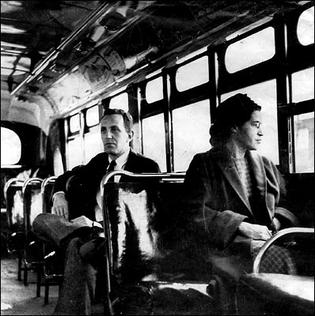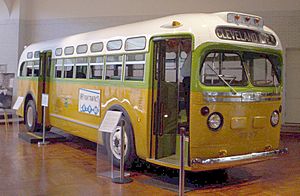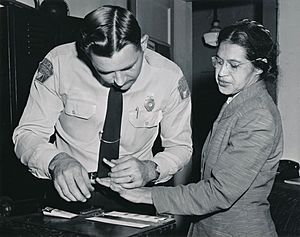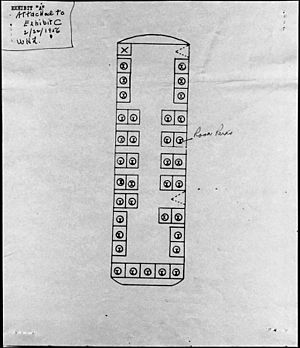Montgomery Bus Boycott facts for kids
Quick facts for kids Montgomery bus boycott |
|||
|---|---|---|---|
| Part of the Civil Rights Movement | |||

Rosa Parks on a Montgomery bus on December 21, 1956, the day Montgomery's public transportation system was legally integrated. Behind Parks is Nicholas C. Chriss, a UPI reporter covering the event.
|
|||
| Date | December 5, 1955 – December 20 , 1956 | ||
| Location |
Montgomery, Alabama, U.S.
|
||
| Caused by |
|
||
| Resulted in |
|
||
| Parties to the civil conflict | |||
|
|||
| Lead figures | |||
|
|||
The Montgomery Bus Boycott was a very important event in the Civil Rights Movement. This movement worked for equal rights for all people. The boycott happened in Montgomery, Alabama. At that time, city buses were segregated. This meant that Black people and white people had to sit in different sections. Black passengers were required by law to ride in the back of the bus.
On December 1, 1955, Rosa Parks, an African American woman, refused to give her bus seat to a white person. She was arrested and sent to jail. To protest this unfair rule, about 40,000 Black people decided to boycott the Montgomery city buses. They refused to ride them. The boycott lasted for 381 days.
On November 13, 1956, the United States Supreme Court made a big decision. They ruled that the buses must be desegregated. This meant that segregation on buses was illegal. Because of this, the city of Montgomery passed a new law. It allowed Black passengers to sit anywhere on the buses. The boycott finally ended on December 20, 1956. Many important leaders in the civil rights movement took part. These included Reverend Martin Luther King, Jr. and Ralph Abernathy.
Contents
History of Segregation on Buses
In Montgomery, the bus system had strict rules about seating. The first ten seats were always for white people. The back ten seats were supposed to be for Black people. In the middle section, there were sixteen seats. These seats could be used by both white and Black people, but they had to stay separate.
White people filled the middle seats from the front to the back. Black people filled seats from the back to the front. If more Black people got on the bus, they had to stand. If a white person got on and there were no white seats, Black people in the front row of the middle section had to move. This made a new row for white people. It was against the law for white and Black people to sit next to each other. When Rosa Parks refused to move, she was in the first row of this middle section.
Often, Black people had to pay their fare at the front of the bus. Then, they had to get off and re-enter through a separate door at the back. Sometimes, bus drivers would drive away before Black passengers could get back on. The company that owned the Montgomery Bus Line was National City Lines. The United Auto Workers union gave almost $5,000 to help the boycott.
Rosa Parks' Stand
Rosa Parks (born February 4, 1913 – died October 24, 2005) worked as a seamstress. She was also the secretary for the Montgomery chapter of the NAACP. Years before her famous arrest, a bus driver named James F. Blake stopped her from getting on a bus. He told her to use the back door, then drove off without her. Parks promised herself she would never ride a bus driven by Blake again.
In 1955, Parks took a course about "Race Relations" in Tennessee. There, people talked about using nonviolent ways to protest unfair laws. On December 1, 1955, Parks was sitting in the first row where Black people could sit. This was in the middle section of the bus. When a white man got on, the bus driver told everyone in her row to move back. At that moment, Parks realized it was the same driver, Blake.
All the other Black people in her row moved. But Parks refused. She was arrested for not obeying the driver's orders. City rules did not directly say people had to be segregated. But they did give bus drivers the power to assign seats. On December 5, Parks was found guilty. She was fined $10 plus $4 in court costs. She decided to appeal this decision.
E. D. Nixon's Leadership
Some efforts against segregation were already happening before Rosa Parks' arrest. These efforts were led by E. D. Nixon. He was the president of the local NAACP chapter. Nixon wanted Parks' arrest to be a "test case." This meant he wanted to use her case to challenge the segregation laws in court.
Community leaders had been looking for the right person to be arrested. They needed someone who would make the Black community want to act. This person also had to agree to challenge the laws in court. Most importantly, they needed someone who was respected by everyone. When another young woman, Claudette Colvin, was arrested earlier in 1955, Nixon thought she might be the one. But he later decided Parks was a better choice because of her job and good standing in the community.
Between Parks' arrest and her trial, Nixon organized a meeting of local ministers. This meeting was held at Martin Luther King Jr.'s church. Nixon chose King to lead the new group that would guide the boycott. This group was called the "Montgomery Improvement Association" (MIA). Nixon wanted King to lead because he was new to Montgomery. This meant city leaders had not had time to try and scare him.
At a larger meeting, some ministers were hesitant to support the boycott. Nixon spoke strongly, reminding them that their church members worked hard to give money to the church. He said that when those members needed help, the ministers should stand up for them. King then spoke up, saying he was not afraid. King agreed to lead the MIA, and Nixon became its treasurer.
The Boycott Begins

On the night Rosa Parks was arrested, the Women's Political Council (WPC) quickly acted. Led by Jo Ann Robinson, they printed and shared flyers all over Montgomery's Black community. The flyers told people about Rosa Parks' arrest. They asked every Black person to stay off the buses on Monday to protest. They urged people to walk, take a taxi, or find other ways to get around.
The next morning, the new Montgomery Improvement Association (MIA) held a meeting. About 16 to 18 people met to plan the boycott. Rosa Parks was there and received a standing ovation. A citywide boycott of public buses was proposed. They had three main demands:
- Bus drivers should treat all passengers politely.
- Passengers should be seated on a first-come, first-served basis. Black people would sit in the back half, and white people in the front half.
- Black people should be hired as bus drivers on routes where most riders were Black.
These demands were a compromise. The boycott leaders thought the city would be more likely to accept them than a demand for full integration right away. This plan was approved, and the boycott was set to start the following Monday. To spread the word, the boycott was announced in Black churches across Montgomery that Sunday.
On Saturday, December 3, it was clear that the Black community would support the boycott. Very few Black people rode the buses that day. On December 5, a large meeting was held at the Holt Street Baptist Church. The goal was to decide if the protest would continue. With only twenty minutes to prepare, King gave a powerful speech asking for the bus boycott. Everyone there enthusiastically agreed. Starting December 7, the FBI began watching the "agitation among negroes" and tried to find negative information about King.
The boycott worked very well. So many riders stopped using the buses that the city's transit system lost a lot of money. Martin Luther King later wrote that "a miracle had taken place." Instead of riding buses, boycotters organized carpools. Car owners volunteered to drive people to different places. Some white housewives also drove their Black domestic workers to their jobs. When the city tried to stop insurance companies from covering the carpool cars, the boycott leaders found insurance from Lloyd's of London.
Black taxi drivers helped by charging only ten cents per ride. This was the same price as a bus ticket. City officials found out about this on December 8. They ordered that any taxi driver charging less than 45 cents would be fined. Besides cars, some people walked, cycled, or even rode mules or horse-drawn buggies. Sidewalks were often crowded during busy times. Since the buses had very few passengers, officials asked the City Commission to stop bus service to Black communities. Across the country, Black churches raised money to support the boycott. They also collected new and used shoes for Montgomery's Black citizens. Many people walked everywhere instead of riding the buses and following Jim Crow laws.
In response, the number of white people joining the White Citizens' Council doubled during the boycott. These groups sometimes used violence. King's and Abernathy's houses were attacked with firebombs. Four Black Baptist churches were also bombed. Boycotters were often physically attacked. After the attack on King's house, he spoke to 300 angry African Americans who had gathered outside. He told them:
If you have weapons, take them home; if you do not have them, please do not seek to get them. We cannot solve this problem through retaliatory violence. We must meet violence with nonviolence. Remember the words of Jesus: "He who lives by the sword will perish by the sword". We must love our white brothers, no matter what they do to us. We must make them know that we love them. Jesus still cries out in words that echo across the centuries: "Love your enemies; bless them that curse you; pray for them that despitefully use you". This is what we must live by. We must meet hate with love. Remember, if I am stopped, this movement will not stop, because God is with the movement. Go home with this glowing faith and this radiant assurance.
King and 88 other boycott leaders and carpool drivers were accused of trying to interfere with a business. This was under a 1921 rule. Instead of waiting to be arrested, they turned themselves in. This was an act of defiance. King was ordered to pay a $500 fine or spend 386 days in jail. He ended up spending two weeks in jail. This action actually helped the protest by bringing it national attention. King said about his arrest: "I was proud of my crime. It was the crime of joining my people in a nonviolent protest against injustice."
Local groups also played a big part in the boycott. Groups like the Club from Nowhere helped raise money and keep spirits high. Many members of these groups were women. Their help was very important to the boycott's success.
Victory for Civil Rights
Pressure for change grew across the country. A related court case was heard in federal court. On June 5, 1956, the court ruled in Browder v. Gayle (1956) that Alabama's laws for racial segregation on buses were against the U.S. Constitution. The state appealed this decision, so the boycott continued. The case then went to the United States Supreme Court. On November 13, 1956, the Supreme Court agreed with the lower court's ruling.
The bus boycott officially ended on December 20, 1956. It had lasted for 382 days, starting on December 5, 1955. The Montgomery bus boycott had a huge impact. It led to the desegregation of public buses. It also encouraged more people in the South to join the national Civil Rights Movement. And it brought King national attention as an important leader.
See also
 In Spanish: Boicot de autobuses de Montgomery para niños
In Spanish: Boicot de autobuses de Montgomery para niños




